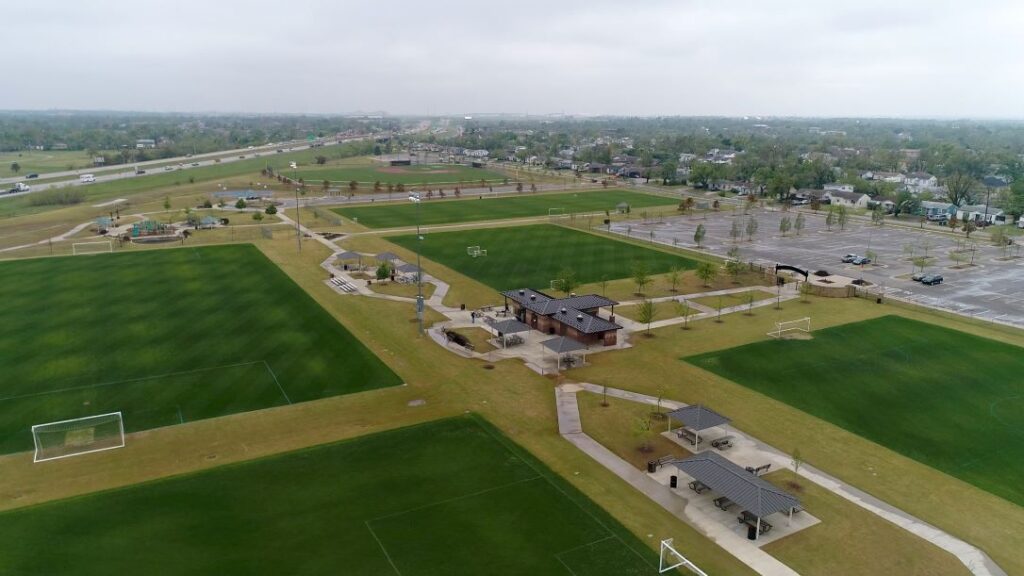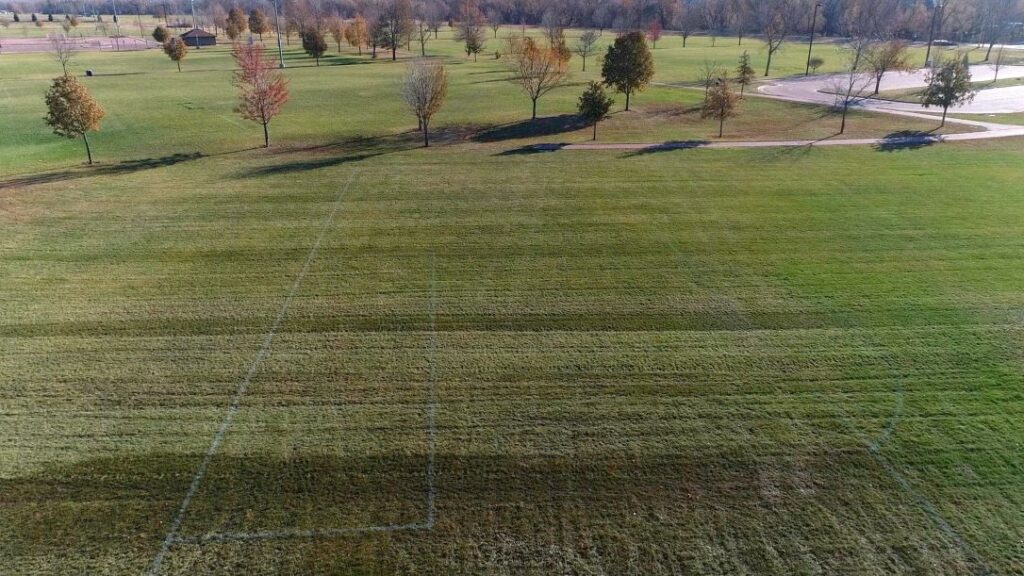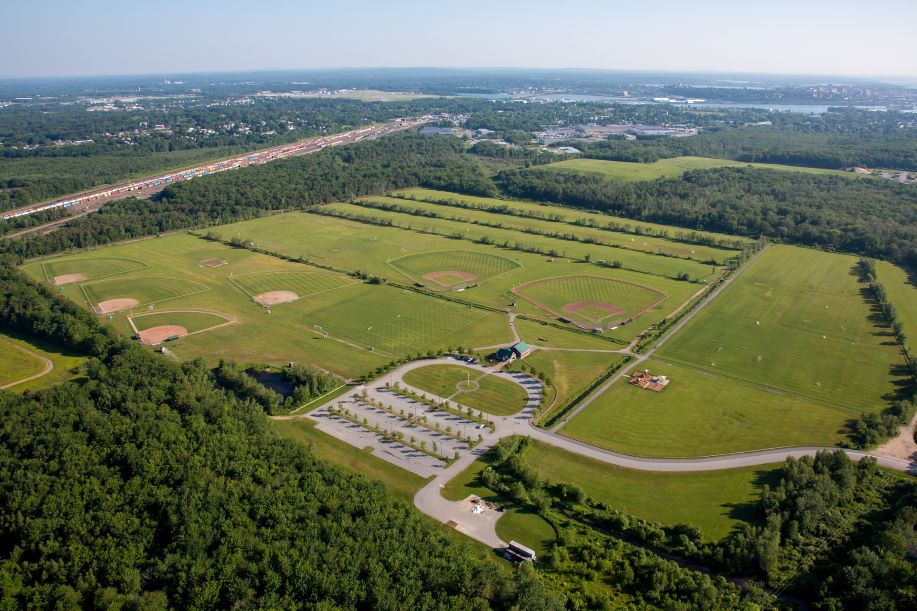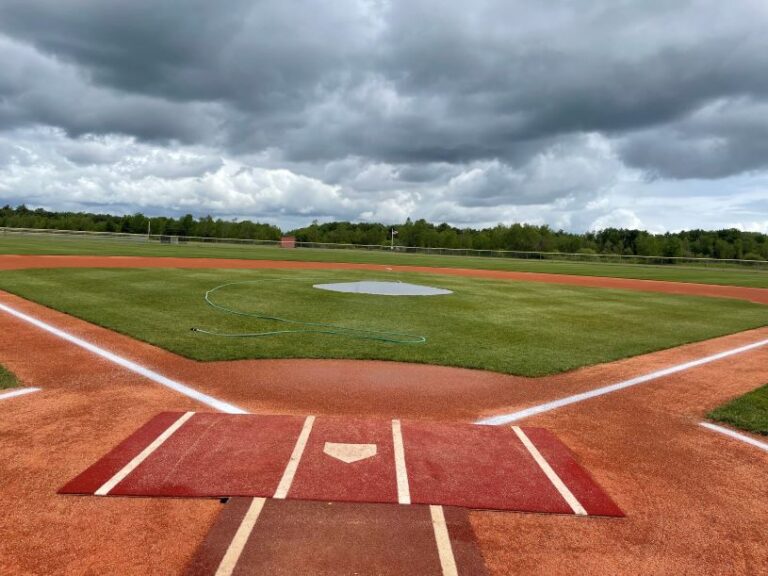By John Kmitta
Parks and recreation professionals who have attained the Certified Sports Field Manager (CSFM) certification are recognized experts in their field. In honor of Park and Recreation Month, I recently spoke with several parks and rec CSFMs about Park and Recreation Month, the challenges they face, sustainability efforts, and the value of certification.
Park and Recreation Month
The CSFMs with whom I spoke embrace Park and Recreation Month and its messaging.
“During Park and Recreation month, we try to recognize our employees for the hard work that they put in throughout the year with different employee activities, rewards, food and recognition,” said Brad Thedens, CSFM, park caretaker, Sioux Falls, South Dakota. “The recreation department does a lot of activities throughout the park system, community centers, pools and media outlets to engage the community to be active and showcase the great park and recreation opportunities we offer.”
Steve Hamilton, CSFM, park maintenance supervisor, City of Surprise, Arizona, said Park and Recreation Month is important because he and his family live, work and play in their community in Surprise. “Not only do I work for the Parks and Recreation department, but I also volunteer coach for my children’s sports,” he said. “Being a steward of the community and entrusted to ensure our parks are clean, green and safe means the taxpayer dollars are spent to ensure green spaces and open public spaces are areas of tranquility, fun and respite from the world.”
“Our mayor will be delivering a proclamation for Park and Recreation month, and our marketing team will be nose to the grindstone putting out information throughout the month of July,” said Ryan Ferguson, CSFM, athletic field groundskeeper, City of Oklahoma City. “We do these things to ensure our community is aware of positive social interactions in all aspects of parks and recreation – from nature parks to youth organizations and childcare to athletic fields.”

The City of Louisville, Colorado, celebrates Park and Recreation Month with a “Flat Louis” (similar to “Flat Stanley”), said Abby McNeal CSFM, CPRP, parks superintendent, parks, forestry, cemetery and streetscapes, Louisville, Colorado. The parks and rec travels and fun that “Flat Louis” has during the month of July showcase the tasks performed to create great spaces for the community.
“We promote the great things that our operations and maintenance staff, as well as our recreation staff do that impact and support healthy lifestyles in our community,” McNeal added.
Brent Neighbor, CSFM, deputy director, parks & recreation, City of Marion (Iowa), said the initiatives highlighted during Park and Recreation Month are messages his department embodies year-round.
“We try to stress to our staff on a regular basis that what they do is important for our community,” he said. “We provide quality-of-life services that make our community an attractive place to live, work and play.”
Said Rick Perruzzi, CSFM, CPRP, recreation manager of outdoor athletic facilities, South Portland (Maine) Department of Parks, Recreation & Waterfront, “It is always our goal to provide the best level of service given our resources and staffing levels. We have set the bar high in regard to the services and overall experience for our user groups, which they have come to expect. I feel we have been able to keep the experience positive for all users of our facility.”
According to Jason Puopolo, CSFM, parks operations superintendent, City of West Sacramento, his city is very active with Park and Recreation Month.
“We have it be a big part of what the city is; we have an event; the mayor makes a proclamation; we try to do something with the theming,” he said. “I’ve grown to enjoy it and it gets the public involved. It shows there is a level of professionalism to what we do, and it helps younger people see that this is an actual career.”
Parks and rec challenges
According to the CSFMs, some of the biggest challenges they face include hiring/staffing, funding, time management, and field/facility traffic and usage.
“As with any municipality, the issue of finding staff continues to be the biggest challenge,” said Perruzzi. “In regard to full-time staff, being in a unionized workplace, it is difficult to find employees with experience who might want to take a pay cut and start at the bottom. Recruitment is not an option in hiring full-time staff members.”
McNeal added that it is a challenge to hire quality staff members who want to be trained and work in their communities.
“We market it as making a difference and impact in your backyard,” said McNeal. “We also share the trainings that we offer and how these grow the candidate. Parks and recreation is fun!”
Said Puopolo, “We are always growing, and we always try to stay ahead of it in terms of staffing, but it’s the hardest pitch to make, because it is a reoccurring thing – especially in a union setting, because there are contracts in place. You would be surprised at what a staff member costs when you are not just looking at the hourly rate. That, by far, is the biggest challenge we have with regard to budgeting.”
According to Hamilton, park professionals have also had to become increasingly creative with timelines for maintaining and improving the quality of parks.
“Our parks are open to the public 15 hours a day, 365 days a year,” he said. “It becomes difficult to fit in all your maintenance practices and projects in without shutting down amenities to the public. The times we are able to shut down certain amenities/areas, there are many facets of outreach so we can target as many users as possible. Communication with the public is always key!”
Thedens echoed the challenges of maintaining a wide range of parks, fields, facilities and amenities, and also stressed the importance of proper communication.

“Within the park system I maintain we have not only soccer fields but tennis courts, dog parks, disc golf courses, cross country courses, special events and recreational trails, just to name a few,” said Thedens. “Trying to provide the best service and products for this wide range of activities is probably the biggest challenge I face. Communication is the biggest key to approaching this challenge – communicating with the user groups and upper management, but also effectively communicating and educating the seasonal staff on the importance of what they do and how it matters to the community.”
Added Puopolo, “While we are sports turf managers, that is not all that we do. We are an urban forestry department, we manage waterfront facilities, and we manage restroom facilities, so there is a custodial aspect to it. As much as I would love to nerd out and focus on sports turf, there is always something different that we are doing. I am always trying to educate the different user groups and the community that sports fields are not all that we do.”
According to Neighbor, it is challenging to get sufficient funding for maintaining high levels of service while running programs and tournaments seven days per week.
Ferguson added that managing field traffic and usage is key. “We, as a city, are growing at an incredible rate, and adding fields and facilities for our ever-growing population has presented a significant challenge,” he said. “We are in the process of adding facilities to distribute athletic field access more evenly to our community, and this will aid us in providing top-tier fields for our community. That said, Oklahoma City is the second largest capital by area in the United States, so this presents a host of scheduling challenges because of travel time to and from these facilities. At the end of the day, these are good problems to have, and they keep us on our game.”
Building a sustainable future
One area in which parks and recreation professionals need to be “on their game” is that of sustainability. Environmentally friendly practices and green initiatives are vital for our communities and an important part of park and recreation management.
“We find a point in all that we do – daily operations and projects – to align with our agency’s sustainable goals,” said McNeal. “Water conservation, turfgrass reduction, pollinator and native landscape plantings, chemical reductions, and de-carbonization equipment. Our community is heavily focused on enhanced sustainable practices, and we strive to adapt those that align with our maintenance and operations practices where appropriate.”
“Parks will always be a way to connect to nature,” said Hamilton. “We are exploring ways to be even better with recycling soils from different projects to topdress grass. Using more green-certified products (humid acid, soil inoculants and green waste compost). We are currently working with our water department to assist us in with grants for water-use reduction; and we are also identifying smart water practices. Lastly, my favorite: biosolids, which are still under research with the state and local college. Biosolids are a byproduct of wastewater treatment. Solid waste is put in a giant greenhouse dryer and all water is removed before it goes to the landfill. This saves water and money. The uses once cleared could be a free fertilizer for grass and farms.”

Perruzzi said his goal has always been to look for better products – not just for the turf, but to also minimize any impacts to the environment. However, he added that those efforts come with challenges.
“As stewards of the environment, it is our responsibility to ensure the safety of not just our direct users but also our indirect groups,” he said. “In our community, ordinances have been passed regulating the use of fertilizers and pesticides. Unfortunately, our ability to make educated decisions has been taken away from us and been instructed by policymakers how to maintain our athletic fields. It has nothing to do with our resistance to try new products and technologies, but I feel there needs to be a balance as alternative products are being improved.
“As stewards of the environment, we understand and appreciate the impacts on the environment around our communities,” he added. “But, ultimately, a healthy, vibrant turfgrass system is an asset to not just the user groups but also the surrounding areas as nature’s best filter.”
Thedens said that his department has been proactive in providing natural areas, green buffers around waters, and best management practices to help lessen the impact on the environment. He added that this is an ongoing focus and continues to be at the front of decision making now and moving forward.
“Most turf professionals have always been leaders in responsible stewardship of the environment,” said Neighbor. “Integrated Pest Management (IPM) is one example of a practice that industry professionals have been using for decades. I like to say that targeted use of the right product with the right amount is how IPM came about.”
Ferguson said his department has invested in technology such as robotic painters to cut down on fuel emissions and GPS-guided spray rigs to ensure that there is not an unnecessary amount of chemical being applied.
“I have turned much more to the train of thought with fertilization that if I feed the soil with more organically based fertilizers and not focus solely on feeding the plant that I can achieve a great deal of success,” Ferguson added.
According to Puopolo, he has worked with his city to develop an IPM plan that touches on many different departments.
“I always try to explain to people that it suits us in a lot of different ways to be as sustainable as possible,” he said. “It doesn’t serve me well to go out and dump as much pesticide as possible. Everything we do every day has an impact on sustainability. It’s part of our daily operations, and we are always trying to be better.”
Certification and professionalism
With that goal of trying to be better in mind, certification – as Certified Sports Field Managers and/or as Certified Park and Recreation Professionals (CPRP) – has helped our respondents attain respect in the industry, within their organizations, and in their communities.
“Having that added credential – while the public may not know the full depth and scope of the association and the certification – is something that they can trust in the information we are giving them,” said Puopolo.
Puopolo added that being certified has been a huge help when he is involved with city council meetings or parks commissions meetings, because the council members, commissioners and the community can trust in the feedback he provides.
“Certification validated that we are professionals and not just the folks who cut the grass and paint a few lines,” said Perruzzi. “Early on in my career, it was hard to be recognized as a professional – especially as a “parks” employee. But showing my supervisors the drive and passion to take our fields to the next level and following through on this vision allowed us to secure resources to be able to further the improvement of our athletic fields.”
Neighbor added that certification demonstrates a commitment to the industry and a level of professionalism that some people outside of the green industry may not have known existed.
“My certifications – CSFM and CPRP – have been used to show the expertise and commitment to the industry that I bring to my agency,” said McNeal.
Said Hamilton, “Being a CSFM doesn’t just open doors, it builds bridges between departments. This is an industry badge that opens opportunities to share what we do in an informative manner. With the knowledge I have gained, it has allowed me the opportunity to share with our staff and build our team. I encourage them to participate in learning opportunities to help them grow and show the possibilities to others.”

According to Ferguson, being a Certified Sports Feld Manager has helped provided him with the tools needed to address issues or concerns that come up during the construction of new facilities, as well as the knowledge and insight into an evolving industry through lessons learned and new resources.
Said Thedens, “The knowledge, skills, continuing education and connections that have come with being a Certified Sports Field Manager have definitely helped me to not only try to provide safe, quality fields, but to also help educate decision-makers, parents, players and the community about the importance of sports field management in providing those desired outcomes.”
John Kmitta is associate publisher and editorial brand director of SportsField Management magazine.


